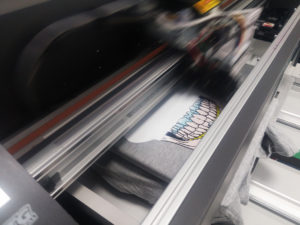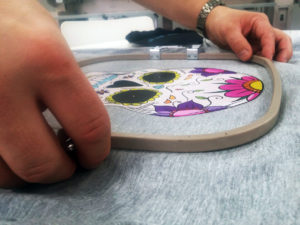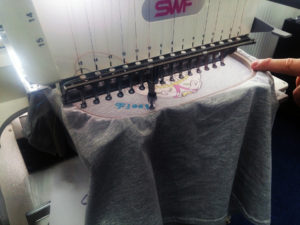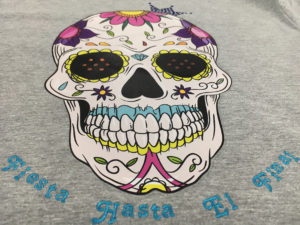
John-Paul Burton, director of Your Embroidery Services Ltd discusses the possibilities of combining embroidery and direct to garment printing and how you can monopolise from this in your own print shop.
Many of you reading this will be specialists in particular forms of garment decoration or promotion.
Some of you may already have expanded your remit to include other promotional items such as pens, mugs, etc. It is also possible though that many of you will not have considered this because you perhaps think that the outlay is too high or the learning curve too steep but, with modern development and streamlined production techniques, this is not necessarily the case.

Embroidery and printing are tried and tested techniques for ‘branding’ garments but there are other ways that this can be achieved – either as stand-alone procedures or by combining other forms of decoration. Adding spangles for instance gives another dimension to the design. In the past the cost of this may have been prohibitive but there are machines out there now that are not much bigger than a small office printer and, although a little more expensive, still fall easily within the average investment budget.
Time means money
Combination decoration of course is not new. Embroidery and print have been used together or many years but, due to the difficulty of registration, production was never easy and it therefore never reached the heights of popularity it deserved.

Not only does this form of decoration look good it also gives you the ability to cover large areas of a garment without the high production cost.
To cover the front of a T shirt with embroidery for instance you would probably need a design with between 60,000 and 70,000 stitches. Convert the biggest chunk of that design to print and use the embroidery to highlight key areas and you could end up with an embroidery design that only needs 4,000 or 5,000 stitches. On an embroidery machine that is the difference between one and a half hours and six and a half minutes and, as time means money…?
“There is still the registration problem though” I hear you say. Well, no there isn’t! If you simply speak to your supplier and explain what you are looking to do then they should be able to come up with a plan that will make the process easier and more productive for you.
Embroidery and print
Let’s look at embroidery and print again as this is likely to be the most common combination. Many of the major machine suppliers have worked with the manufacturers to ensure that the same graphic file can be used to generate output for both formats. In some instances the same software can be used to generate a pattern for both embroidery and print. Much of this is aimed at the direct to garment print sector so you may think that you can only achieve results in the small order market but recent developments in this sector have resulted in bridge machines that are capable of handling both small and bulk orders. Even the accuracy of setting up embroidery machines has improved over the years with the addition of laser sighting to machines giving the ability to exactly position the garment so that print and embroidery become seamlessly integrated.

Spangling is another form of decoration that can be added into this mix. Previously this was a fiddly and, sometimes, messy operation and tended to live on its own as a form of decoration. It was also seen as a bit sparkly and therefore only aimed at the fashion side of garment decoration but recent developments have changed this.
The variety of spangle design and colours as well as a much easier and productive way of attaching them now brings this technique into the mainstream. It gives you the ability to offer something different to your customer and this could give you the edge over your competitors.
Combined decoration
When looking at combined decoration think hard about how the design will work with the different techniques. By merging different formats you are creating a 3D effect so the flattest of these formats will go down first. In other words the accepted order of play is print first, then embroidery and finally spangles although there is no reason that this cannot be varied if the design demands it.

The key is to think about the end result and how it will look and perform. For branded garments they mostly need to be serviceable so keep this in mind when designing.
In 2017 combined decoration is not only possible but it is also desirable. In this high speed, ever changing, fashion conscious world this industry, like all others, is always looking for something new. Your customers want something that sets them apart and they look to you to make their ideas and desires a reality.
 Printwear & Promotion The Total Promotional Package
Printwear & Promotion The Total Promotional Package




